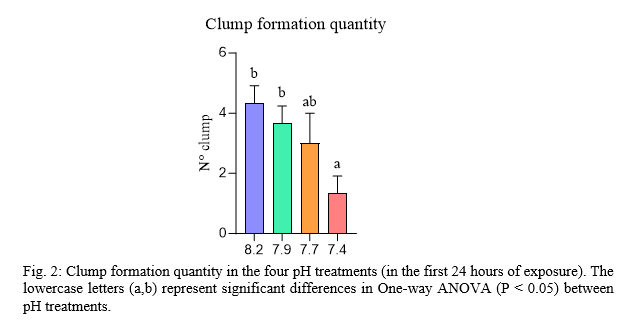ASSESSING THE IMPACT OF CLIMATE CHANGE-DRIVEN ACIDIFICATION IN THE ADRIATIC SEA ON BYSSUS PRODUCTION, BEHAVIOUR, AND SHELL BIOMINERALIZATION IN Mytilus galloprovincialis
Introduction
The increase in atmospheric CO₂ levels is causing a progressive acidification of sea water. Projections indicate a decrease in ocean surface pH by approximately 0.3–0.5 units by the year 2100. This future condition could affect calcifying marine organisms, particularly bivalves, due to their reliance on carbonate ions for shell formation. Mytilus galloprovincialis, the Mediterranean mussel, is both ecologically important and economically valuable in European aquaculture. This study aims to investigate how predicted acidification scenarios may influence mussel byssus production, gregarious behaviour, shell integrity, and molecular responses related to calcification.
Materials and Methods
M. galloprovincialis (n = 288; shell length 3.5 ± 0.5 mm) were collected from a commercial mussel farm in the North Adriatic Sea and acclimatized in controlled laboratory aquaria. The mussels were then randomly assigned to four experimental pH treatments (8.2 – control, 7.9, 7.7, and 7.4), simulating current and predicted future ocean conditions based on IPCC projections. pH was modulated and stabilized using CO₂ bubbling systems over a 90-day exposure period. Total alkalinity was measured weekly to determine carbonate system parameters, including aragonite and calcite saturation state.
Byssus thread production was assessed at multiple intervals (1, 3, 6, 9, 12, 18, and 24 hours). Mussel positions were recorded on a grid at the bottom of aquaria, to quantify clumping events in aggregation behaviour and crawling speed (mm/h).
Shell quality was evaluated through scanning electron microscopy (SEM), mechanical strength testing under pressure, and mineralogical analysis via X-ray diffraction.
Histological analyses of mantle tissue were conducted using Alizarin Red S staining to localize calcium deposits useful for shell formation.
Furthermore, expression levels of key genes associated with biomineralization (chitin synthase, calponin-like protein, carbonic anhydrase, tyrosinase 1–2, chinase, plasma membrane Ca²⁺ ATPase and sarcoplasmatic Ca²⁺-binding protein) were quantified using RT-qPCR on outer and inner mantle tissue samples.
Results and Discussion
No significant decrease in byssus production was observed between pH treatments, only an increase over time (Fig.1). But behavioural alterations emerged such as decreased clumping (Fig.2) and mobility under low pH conditions. Mussels exposed to acidified seawater compromised shell ultrastructure and mechanical properties, with altered mineral phase composition. At the tissue level, a redistribution of calcium within the mantle parts was observed, suggesting disruptions in shell formation processes. Gene expression analyses revealed downregulation of biomineralization-related genes under low pH, indicating impaired physiological regulation of shell formation.
Conclusion
This study provides a comprehensive assessment of the effects of ocean acidification on M. galloprovincialis, integrating behavioural, morphological, and molecular endpoints, it highlights the species’ sensitivity to low seawater pH, with implications for mussel productivity under future climate scenarios.
References
Nicastro, K., et al. (2007), Behavioural response of invasive Mytilus galloprovincialis and indigenous Perna perna mussels exposed to risk of predation. Marine Ecology Progress Series, 336, 169-175.
Fan, X., et al. (2023), Metabolic profiling of Mytilus coruscus mantle in response of shell repairing under acute acidification. PLoS ONE, 18(10), e0293565.
Hüning, A. K., et al. (2016), A shell regeneration assay to identify biomineralization candidate genes in mytilid mussels. Mar Genomics, 27, 57-67.

